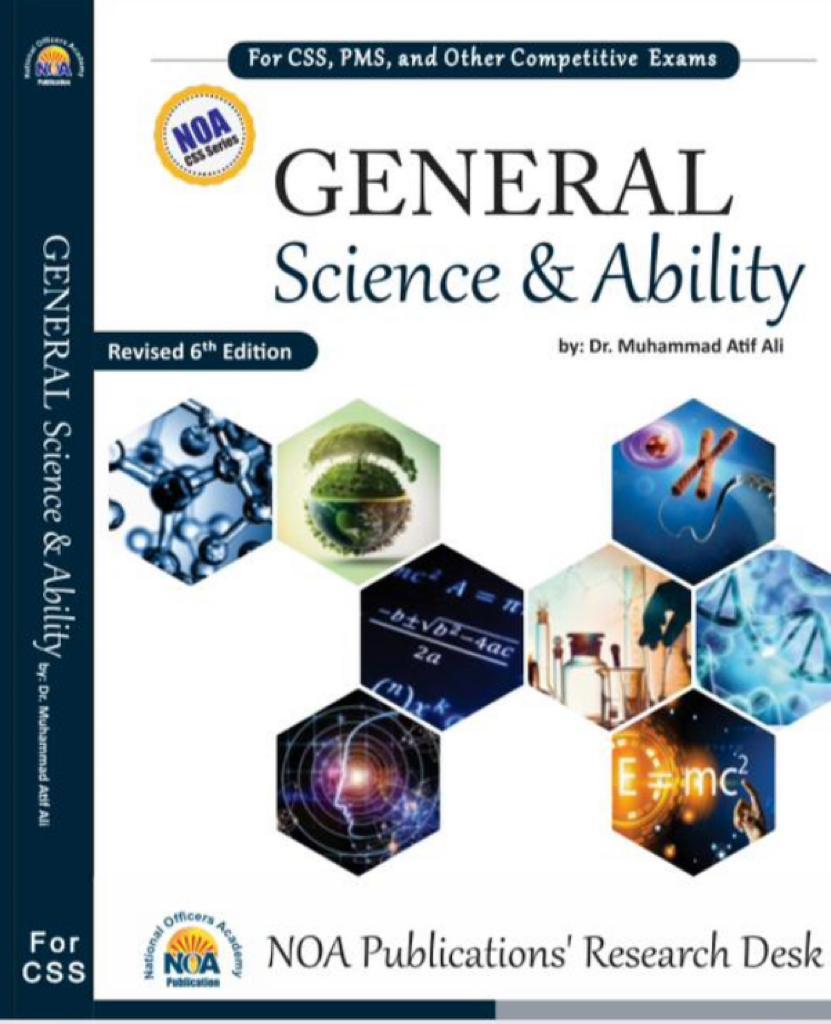General Science & Ability By Dr Muhammad Atif Ali (NOA Publication)
Best For Competitive Exams (CSS,PMS ,PCS & All Descriptive Exams)
PREFACE
Importance of ‘General Science and Ability’ as a subject cannot be denied in any competitive examination both from the perspective of scoring high marks as well as considerable overlapping with many other subjects. This subject arguably forms the backbone of any competitive examination in general and CSS / PMS in particular. This subject, without any exaggeration, contributes significantly in overall marks obtained in written examination by aspirants. This edition has been designed and written to meet the expanding interest of the aspirants in the subject. This handy refresher would enable the aspirants to acquire a complete and detailed understanding of all topics included in the course of CSS examination by FPSC. Furthermore, this book is immensely useful for other subjects mainly Essay, Environment Science, Physics, Statistics, Geology, Town Planning and Urban Management, Agriculture and Forestry, Psychology and Geography. This revised edition is based on a number of consideration: (1) based on feedback of earlier editions, massive amendments and corrections have been made in this edition; (2) recommended books by FPSC have been majorly used as reference material; (3) each topic is designed in five levels of exposition; i.e. topic name, main heading, sub-heading, type and classification heading and examples; (4) unique info-graphics and graphical data is extensively incorporated to provide readers with a competitive edge over others; and, (5) inclusion of topic-wise questions from previous year papers.
I am humbly indebted to number of people how, directly or indirectly, contributed by sharing their valuable ideas and suggestions regarding book preparation. My special thanks are extended to my parents, teachers, colleagues and family. I am also thankful to those who appreciated this effort and encouraged a lot during this exercise. I am also indebted to my co-authors for providing me their all-out support in compilation of this academic endeavor. Last but not the least, I am exclusively thankful to Mr. Hassan Ali Gondal (Editor-in-Chief) and team of NOA Publications for their tiring efforts and significant contributions towards the quality improvement of this writing.
I wish and pray that this book enlightens the students with the best knowledge gathered at one place. I hope this book will fulfill all the needs and requirements of the aspirants. Every effort was made to make this book the most comprehensive and to the point book on the subject. Simple, clear and lucid language is used. The book is written keeping in mind the knowledge elements of Bloom’s Taxonomy. The material is most authentic and collected from reliable original documents, books and. Finally I take this opportunity to seek your feedback and valuable suggestions, which will definitely go a long way in improving the quality of the contents and producing a much better revised edition.
Dr. Muhammad Atif Ali
Lead Author,
CEO National Officers Academy (NOA),
Patron-in-Chief, NOA Publications.
SYLLABUS
Part-I (General Science) 60 Marks
Section-I. Physical Sciences
A. Constituents and Structure: Universe, Galaxy, Light Year, Solar System, Sun, Earth, Astronomical System of Units.
B. Process of Nature: Solar and Lunar Eclipses, Rotation and Revolution, Weather Variables (Global Temperature, Pressure, Circulation, Precipitation, Humidity) and Weather Variations.
C. Natural Hazards and Disasters: Earth Quake, Volcanic Eruption, Tsunami, Floods, Avalanche, Travelling Cyclone (Tropical Cyclone, Middle Latitude Cyclone and Tornadoes), Drought, Wildfire, Urban Fire. Disaster Risk Management.
D. Energy Resources: Sources of Energy (Renewable i.e. LED Energy, Solar Energy, Wind Energy and Non-Renewable Energy conservation and its sustainable use.
E. Atomic Structure, Chemical Bonding, Electromagnetic Radiations.
F. Modern Materials/Chemicals: Ceramics, Plastics, Semiconductors. Antibiotics, Vaccines, Fertilizers, Pesticides.
Section-II. Biological Sciences
A. The Basis of Life: Cell Structures and Functions (Subcellular Organelles such as Nucleus, Mitochondria and Ribosomes).
B. Biomolecules: Proteins, Lipids, Carbohydrates and Enzymes.
C. Plant and Animal Kingdom: A brief survey of plant and animal kingdom to pinpoint similarities and diversities in nature.
D. A Brief Account of Human Physiology.
E. Common Diseases and Epidemics: Polio, Diarrhea, Malaria, Hepatitis, Dengue their Causes and Prevention.
F. New Model Concept of Producing BIO Fuel Method
Section-III. Environmental Science
A. Environment: The Atmosphere (Layered Structure and Composition), Hydrosphere (Water Cycle, Major Water Compartments), Biosphere (Major Biomes) and Lithosphere (Minerals and Rocks, Rock Types, Plate Tectonics).
B. Atmospheric Pollution: Types, Sources, Causes and effects of major air pollutants (COx, Particulate Matter, NOx, SOx, Tropospheric Ozone, Volatile Organic Compounds, Dioxins). Regional and Global air pollution issues (Acid-rain, Ozone Depletion, Greenhouse Effect and Global Warming). International agreements on air pollution control (Montreal Protocol and Kyoto Protocol).
C. Water Pollution: Types, sources, causes and effects of major water pollutants (Synthetic Organic Chemicals, Oxygen Demanding Wastes, Plant Nutrients, Thermal Pollution, Infectious Agents, Sediments, Radioactivity, Heavy Metals and Acids). Drinking water quality and standards.
D. Land Pollution: Solid waste management and disposal.
Section-IV. Food Science
A. Concept of Balance Diet: Vitamins, Carbohydrates, Protein, Fats and oil, Minerals, Fiber.
B. Quality of Food: Bioavailability of Nutrients, Appearance, Texture, Fiavor, Quality of Packed and Frozen Food, Food Additives, Preservatives and Antioxidants
C. Food Deterioration and its Control: Adulteration, Food Preservation. Causes of Food Deterioration,
Section-V. Information Technology
A. Computer (Hardware & Software Fundamentals); I/O Processing and data storage, Networking & Internet Standards, Application and business Software, Social Media Websites. Information Systems. Fundamentals of artificial intelligence.
B. Telecommunications: Basics of Wireless Communication (Mobile, Satellite, Surveillance and GPS and Fiber Optic etc.
Part-II (General Ability) 40 Marks
Section-VI. Quantitative Ability/Reasoning
A. Basic Mathematical Skills.
B. Concepts and ability to reasons quantitatively and solve problems in a quantitative setting.
C. Basic Arithmetic, Algebra and Geometry (Average, Ratios, Rates, Percentage, Angles, Triangles, Sets, Remainders, Equations, Symbols, Rounding of Numbers
D. Random Sampling
Section-VII. Logical Reasoning and Analytical Reasoning/Ability
A. Logical Reasoning includes the process of using a rational, systematic series of steps based on sound mathematical procedures and given statements to arrive at a conclusion
B. Analytical Reasoning/Ability includes visualizing, articulating and solving both complex and uncomplicated problems and concepts and making decisions that are sensible based on available information, including demonstration of the ability to apply logical thinking to gathering and analyzing information.
Section-VIII. Mental Abilities
A. Mental Abilities Scales that measures specific constructs such as verbal, mechanical, numerical and social ability.
CONTENTS
Part-I- General Science
Chapter-I- Physical Sciences
Constitutes and Structure of Universe
1. Conceptualizing Key Components of ‘UNIVERSE’
2. Theories about Creation and Universe.
3. Methods to Estimate the Age of the Universe.
4. Future of Universe
5. Galaxy
6. Solar System
7. Sun
8. Earth
9. Astronomical Unit (AU)
10. Moon
11. Dark Energy and Dark Matter
12. Black Hole
Processes of Nature
1. Solar and Lunar Eclipse
2. Rotation and Revolution of Earth
3. Weather Variables and Weather Variations
4. Mirage
Natural Hazards and Disasters
1. Earthquake
2. Volcanic Eruptions
3. Tsunami
4. Floods
5. Avalanche
6. Tropical Cyclone
7. Temperate Cyclones
8. Anticyclones
9. Tornadoes
10. Thunderstorm
11. Drought
12. Wildfires
Physical Sciences
A. Constituents and Structure: - Universe, Galaxy, Light Year, Solar System, Sun, Earth, Astronomical System of Units.
B. Process of Nature: - Solar and Lunar Eclipses, Rotation and Revolution, Weather Variables (Global Temperature, Pressure, Circulation, Precipitation, Humidity) and Weather Variations.
C. Natural Hazards and Disasters: - Earth Quake, Volcanic Eruption, Tsunami, Floods, Avalanche, Travelling Cyclone (Tropical Cyclone, Middle Latitude Cyclone and Tornadoes), Drought, Wildfire, Urban Fire. Disaster Risk Management.
D. Energy Resources: - Sources of Energy (Renewable i.e. LED Energy, Solar Energy, Wind Energy and Non-Renewable Energy conservation and its sustainable use.
E. Atomic Structure, Chemical Bonding, Electromagnetic Radiations.
F. Modern Materials/Chemicals: - Ceramics, Plastics, Semiconductors. Antibiotics, Vaccines, Fertilizers, Pesticides.
Constitutes & Structure of Universe
1. Conceptualizing Key Components of 'UNIVERSE'
· Asteroids
These are small rocky objects that revolve around sun between orbit of Mars and Jupiter. 1 asteroid discovered was CERES. Asteroid means "star like".
· Meteoroids
These are small iron and rocky objects resulting from collision of asteroids. These are also formed when comets are disintegrated. When they enter earth atmosphere, they are called meteor. It is a streak of light which can be seen at night. It burns when it enters earth atmosphere due to friction.
· Comets
These are objects made of ice and dust and move around the sun. They may move in 3 type of orbits i.e. elliptical, parabolic and hyperbolic.
Comets have 3 parts, solid center, and a head around center of dust and ice and a long tail of gases.
· Halley's Comet
This name was given after Edmund Halley who calculated orbit of comet in 1705. Halley's Comet visits sun every 76 years. It last visited the sun in 1986 and is predicted to return in 2062.
· Nebula
It is derived from Greek work which means "cloud". In sky, there are cloud like objects which are classified as Nebulae. They are made up of dust and gases.
· Aurora
It is also known as Kutub-e-Roshini. Aurora is a luminous meteoric phenomenon of electrical character seen in Polar Regions with a tremulous motion and giving forth streams of eight Aurora. It is generally believed that aurora is actually caused by radiation from sun spots.
· Constellations
These are group of stars in sky. These were discovered thousands of years ago. Greek astrologers divided the stars in 48 constellations. Today, there are about 88 constellations. They are named after objects like a Swan (Cygnus) or and archer (Sagittarius).
· UFO
UFO stands for unidentified flying objects. These are objects that can be seen in sky but cannot be explained. Many UFO's have later been found to be the planet Venus, which is often very bright.
· The Universe
"The universe is the total of all that exists or has existed, both in space and time". Universe is composed of billions of galaxies. The number of galaxies in the universe is estimated between 1011 to 1012.

